What is land banking? Make money in real estate
Land banking is a real estate investment strategy for investing in undeveloped land to sell it at a future date for a profit.
Most real estate investors typically purchase land parcels located in areas with high population growth or strong economic prospects to maximize the value of their investment.
Many people invest in land because they believe it to be a safe bet — the market value of land generally increases over time as the population grows and expands. While some eventually develop their investment properties, others sit on them as a "nest egg" for the future.
Land banking can be an attractive investment for several reasons. It provides individuals with a chance to get in on developing areas' ground floor, giving them access to potential profits should the area eventually take off.
Developers and long-term corporate land investors with development experience may benefit from land banking.
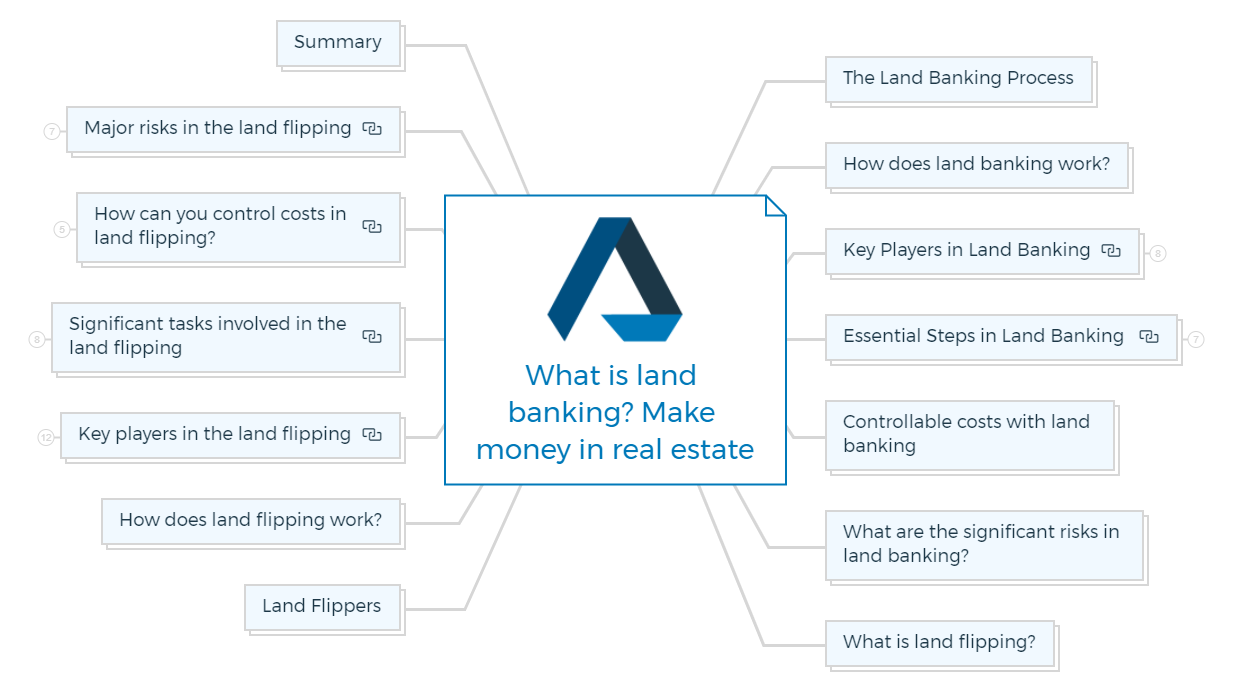
The land banking process
The decision-making process for the Land Banking step is depicted below. Land Bankers store undeveloped land for an indefinite period until they consider the market conditions favorable and decide to sell to Land Flippers.
Land Bankers may also choose not to sell and instead proceed to the Land Flipping stage.
Land banking schematic diagram
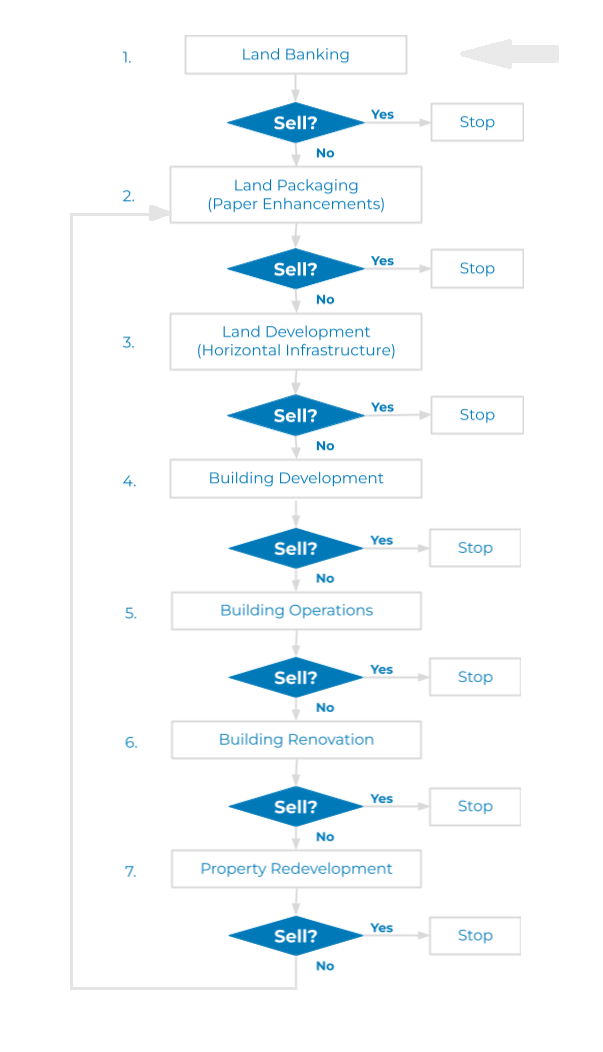
Land bankers buy land with modest promises and sell land with much potential. Land bankers, for example, may purchase land on the outskirts of a city in preparation for the expansion of road infrastructure and utilities.
The most critical tasks in this scenario are correctly estimating the direction and timing of population increase, the expansion of the transportation system and required utilities (sewer, water, electric, and gas), and identifying land parcels that will benefit from these trends.
Land bankers are mostly spectators in the real estate development process, waiting for the projected beneficial market trends to materialize. On the other hand, Land bankers may campaign for their land to be included in a regional land use plan or a regional transportation study.
Land Bankers can also try to have their property annexed into a neighboring municipality to make it more appealing to Land flippers. Land Bankers may also help Land Flippers by arranging purchase money mortgages.
How does land banking work?
Land Bankers can sell the property to a Land Flipper once the land value has increased, or they can finish the Land Flipping Tasks themselves if they have the necessary expertise.
Land Bankers can partake in some of the additional value created in the Land Flipping Stage by providing financing or attractive contract conditions to Land Flippers.
Land bankers require patience, intermediate land uses, and the ability to piece together more land parcels to make the eventual development more feasible.
According to the Land Banking Equation, the eventual sales price must be sufficiently more significant than the sum of the acquisition price and net holding expenses to provide Land Bankers with appropriate financial returns.
This required "spread," or minimum profit, might happen fast or gradually over time.
Land banking equation
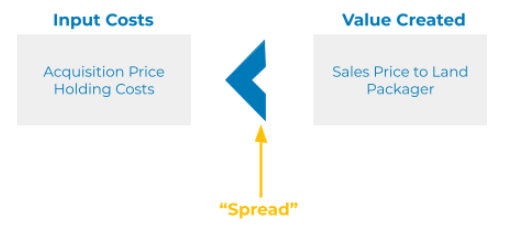
The spread's predicted size reflects the property's expected appreciation over the holding period. Land Bankers, for example, may predict the property's value to double in the future, which is known as a "multiple of two or 2x."
It is a gross measure of return rather than a time-adjusted yearly return. The time-adjusted annual return on the property would be 7.1 per cent if it doubled in value over ten years. Internal rate of return is another term for this.
If the property doubled in value over five or seven years, the time-weighted returns would be 10.4 percent and 19.3 per cent, respectively. These are total returns on the real estate asset, not simply the equity investment.
However, real estate developers must concentrate on the performance of the real estate firm, in this case, passive land holding, to identify the proper capital structure.
Because of the indefinite nature of the holding duration and the annual net holding expenses, financing land banking activities with debt might be difficult.
Development spread
The development spread is defined mathematically as the difference between the going-in and going-out cap rates.
The predicted net operating income (NOI) at stabilization divided by the project's initial cost is the going-in cap rate "Yield on cost" or "development yield".
Development spread example
Let's assess a commercial/office development project.
Total Development Costs = $5000,000
Expected Net Operating Income = $475,000 @ Stabilization
Cap Rate = 9.5%
During our marketing research, we examine recently sold, similar properties in the local market to establish our going-out cap rate. Based on our own internal market data and interactions with local lenders, investors, valuers, and real estate agents, we believe the market cap rate for our completed and stabilized project is 7.5%.
As a result, our going-in cap rate is 9.5%, and our going-out cap rate is 7.5%. Therefore, our Development Spread = 2%
Going in Cap Rate 9.5% - Going Out Cap Rate 7.5% = 2%
In practice, this scenario is also known as "building to a 9.5 cap" and "selling to a 7.5 cap".
The terms "build to" and "sell to" are frequently used by real estate developers to characterize the development spread.
Key players in land banking
The following are some major players in the Land Banking Process in real estate.

Landowners that are looking to sell their property
These are the individuals or organizations who currently hold the land and are motivated to sell it to Land Bankers for various reasons. Examples are farmers who are going out of business or enterprises having excess land due to changing market conditions or facility relocations.
Families with estates selling land holdings to pursue other investments could be motivated sellers.
Real estate brokers
Brokers who specialize in agricultural or rural land transactions have access to critical market data such as recent sales, transaction terms, and possible sellers. They are aware of what land is for sale and the motivation of the current landowners.
Civil engineers and surveyors
Boundary lines, easements, and rights of way must all be determined and verified by surveyors. Civil engineers can assess if the property's future growth potential is suitable.
Engineers and environmental specialists
By conducting a Phase I Environmental Survey, environmental engineers and professionals can determine whether the property has environmental issues or not.
They can also assist in identifying environmental conditions that may impact future development or raise concerns about future land usage.
Title insurance companies and attorneys
Any land purchase should include title insurance for the insurance element in a financial loss because title insurance providers will identify all "exceptions" to the insurance coverage. The title issues arise in these exceptions.
Attorneys must assist in the definition and evaluation of title exceptions and the understanding of deed limitations, easements, and rights of way. Attorneys are also helpful in drafting buy and sale contracts that include the necessary terms.
Politicians and local and regional government officials
Municipalities, counties, states, and the federal government have jurisdiction over the undeveloped territory. Land bankers must know which authorities govern the subject land and its plans.
Whether elected or appointed, politicians frequently have views on how their domains will grow in the future. Land bankers need to know what their customers think so that they may place their bets correctly.
Economists and market analysts
Both governmental and private market analysts are employed to forecast future economic development and population growth. Most national real estate businesses with regional offices also give current and projected market statistics.
Interested land flippers
Potential Land Flippers, who are looking for ways to boost a property's value by acquiring the necessary public approvals for future land development, are Land Bankers' closest friends.
Land Flippers may also look for ways to address or correct existing concerns on the land, such as title issues, survey conflicts, or environmental challenges.
Land Bankers aim to collaborate with Land Flippers for the Land Flippers to acquire the land and obtain the necessary public approvals for development.
Essential steps in land banking
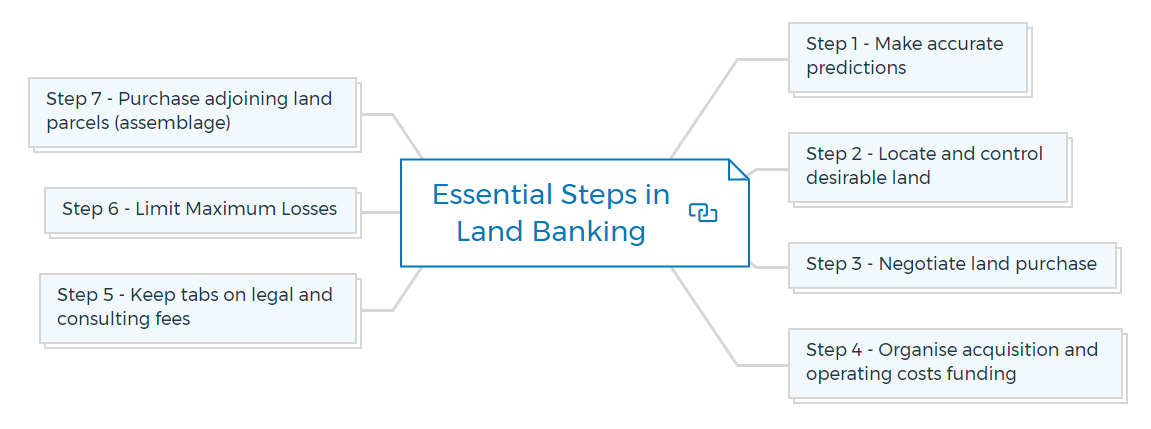
Step 1 - Make accurate predictions
Economic trends, market conditions, and public improvement construction estimates are critical to success. Predictions from land bankers are crucial in determining "when to buy" and "when to sell" a property and promoting the property's worth in light of future economic developments.
Step 2 - Locate and control desirable land
Land bankers must be visionaries who assess land's value in the present and the future. They must determine the qualities of desirable land holdings and devise strategies for maintaining control over the land during the holding period.
There are numerous ways to gain ownership over land without acquiring it together. Purchase options, installment sales, and land leases should all be examined as options for "controlling" the desirable land.
Step 3 - Negotiate land purchase
Land Bankers must negotiate the purchase of the land by meeting the seller's investment expectations while also providing a low enough price for the Land Bankers to keep and carry the land until the market conditions are favorable for a sale.
Step 4 - Organize acquisition and operating costs funding
While waiting for market circumstances to improve and boost the property's value, land bankers must pay the carrying cost of the land. You must pay taxes, insurance, maintenance charges, and finance costs if the property is purchased with a mortgage loan.
Because funding raw land acquisitions through traditional banking sources is typically challenging, Land Bankers must be creative in securing financing from the seller or other investors. Land Bankers must think of interim land uses to help with carrying expenses.
Step 5 - Keep tabs on legal and consulting fees
Even though it is tempting to commission these studies to assist the Land Flippers to envisage the property's possibilities, Land Bankers must be careful not to over-commit to legal studies, market studies, or land use studies.
To keep expenditures under control, land bankers need the discipline of sound bookkeeping, budgets, and monthly reporting.
Step 6 - Limit maximum losses
Land bankers must be cautious about their financial and legal obligations. Non-recourse loans are essential, limiting any liability for current environmental conditions. It's critical to have pre-arranged default arrangements with lenders and indemnifications from previous landowners.
Step 7 - Purchase adjoining land parcels (assemblage)
By acquiring contiguous land parcels that boost the value of the total land holding, land bankers may significantly increase the value of their land. The land may provide better access, visibility, or development opportunities.
Controllable costs with land banking
Costs or expenses that Land Bankers can and must control or limit to the best of their abilities are controllable costs. Before the acquisition, these costs must be recognized and estimated and then closely monitored and managed during the holding term.
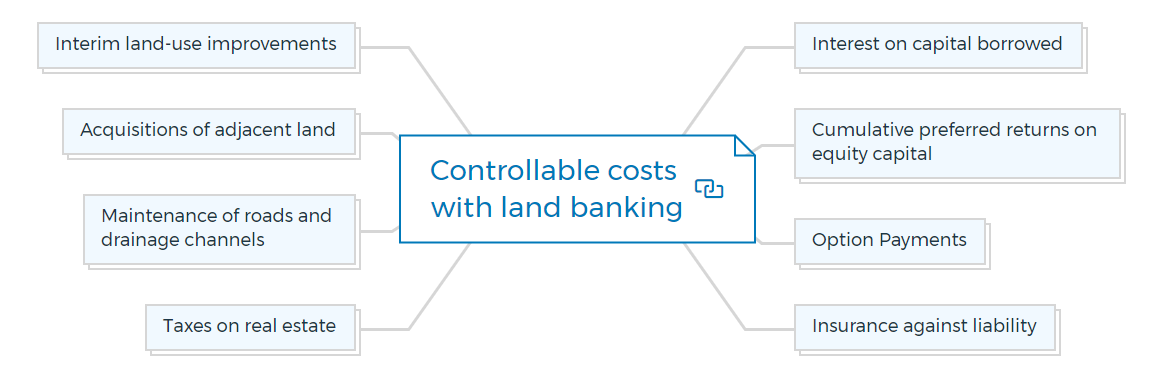
Interest on capital borrowed
Because the Land Banking Stage has the potential to be long-term, interest on borrowed capital should be fixed rather than variable. Some loans may include "pay and accrue provisions," which allow borrowers to pay interest lower than the "contract rate" and accumulate the difference by adding it to the outstanding loan total.
It may be beneficial if market conditions or expenses change unexpectedly, but it is a risky habit to engage in overtime.
Cumulative preferred returns on equity capital
Cumulative preferred returns give some equity owners a higher priority for capital payouts at a set rate. If at all possible, property developers should avoid these provisions.
However, if they are employed, they should be capped at a certain amount and computed annually so that developers know where they stand in terms of capital distributions when the property is sold.
Option payments
If the purchase contract includes option payments, you should explicitly establish the date and amount of the option payments. If necessary, measures should be made to prolong the option agreement.
Insurance against liability
Landowners must have liability insurance, and the policy details, limitations, and premium should be agreed upon before purchasing the property. A cash reserve should be set aside to cover these payments if necessary.
Taxes on real estate
You must pay real estate taxes to municipalities, school districts, and other special taxation districts. These taxes are often known as property taxes or ad valorem taxes.
You must pay these taxes on time and under strict supervision. Early payment reductions should be utilized whenever available. Increasing a property's assessed value is a common way for taxing authorities to increase revenue.
These re-evaluations should be contested and overturned. However, Land Bankers may see the raised assessments as proof of the property's rising market value and promote the property using the new, higher assessment.
Maintenance of roads and drainage channels
While it is necessary to maintain some roadways and drainage channels, you must follow a strict budget. Failure to manage drainage systems, on the other hand, may result in the creation of wetlands and a new set of development restrictions.
Acquisitions of adjacent land
Bigger does not always imply superior. Additional land purchases should be scrutinized for overall value generation (plotting price) and additional financing and carrying costs. It is a critical task with a manageable cost.
Interim land-use improvements
For interim land uses, gates, fences, outbuildings, and security systems must be budgeted for and carefully matched to the rental income associated with their leases. The expenditures should be foreseen and accounted for in the interim land users' leases.

Mastermind Your 1st (or Next) Development
7 Day Challenge
This 7 Day Mastermind Challenge is not just a course. It includes my step-by-step, decision-making frameworks, my go to feasibility tool to vet projects in under One Minute & actionable mind maps showing you my property development process, and property selection strategies.

What are the risks in land banking?
External variables that do not materialize - Interstate highway by-passes are canceled; transit-way work is indefinitely delayed, or public sewer line extensions are not approved as planned.
Also, the new employer may not relocate to the same area, or the manufacturing plant may not expand.
Site qualities and conditions are never valuable - The general population may have thought that the high slopes that provide stunning views were too unsafe to build on. Furthermore, the general public may not have enjoyed the remote area's tranquilly and preferred to remain in more accessible areas.
Financing and other holding charges can quickly add up - Loans with variable interest rates may raise financing costs, or loan extension fees may be excessive. In addition, insurance premiums or property taxes may rise above budgeted amounts. Finally, you may not materialize the revenue anticipated from temporary land uses.
Unforeseen circumstances - Terrorist attacks, wind, fire, rain, earthquakes, and other natural disasters reduce the property's appeal. It's either that or something else! Even if insurance profits and government financing are available, the slow recovery may never result in the predicted increase in land prices.
There is no way to get out of the deal - Every real estate project should include a back door by which the developer can exit from a deal. However, personal guarantees or indemnifications compel Land Bankers to keep the property and suffer financially catastrophic losses.
Issues of collaboration arise - Because the land banking stage is indefinite, some partners may wish to sell the property while others want to keep it. Buy-sell agreements and other partnership conflict resolution measures could force a property sale.
Another difficulty in a partnership is that financial partners experience economic losses and cannot make pledged capital contributions. Partnership concerns can be very personal and non-commercial because inherited landholdings involve many families, generations, and economic ambitions.
What is land flipping?
It is the process of planning and approving a purchased property or lots from Land Bankers or Property Redevelopers for land development. It requires public approvals such as zoning, master plans, environmental impact studies, market studies, engineering analysis, financial projections, surveys, and title insurance.
Real estate investors and developers constantly improve the paper, but it's not usually a separate development stage. This stage has unique tasks that demand different talents than Land Bankers, Property Redevelopers, and Land Developers.
Land flippers
Land flippers buy from land bankers and property redevelopers. They buy "Greenfields" from Land Bankers or "brownfields" from Property Redevelopers and add "paper upgrades" like title insurance, correct surveys, or environmental studies.
The diagram below shows how Land flippers sell upgraded properties to Land Developers. They can become Land Developers, but their talents are significantly different.
Land packaging schematic diagram
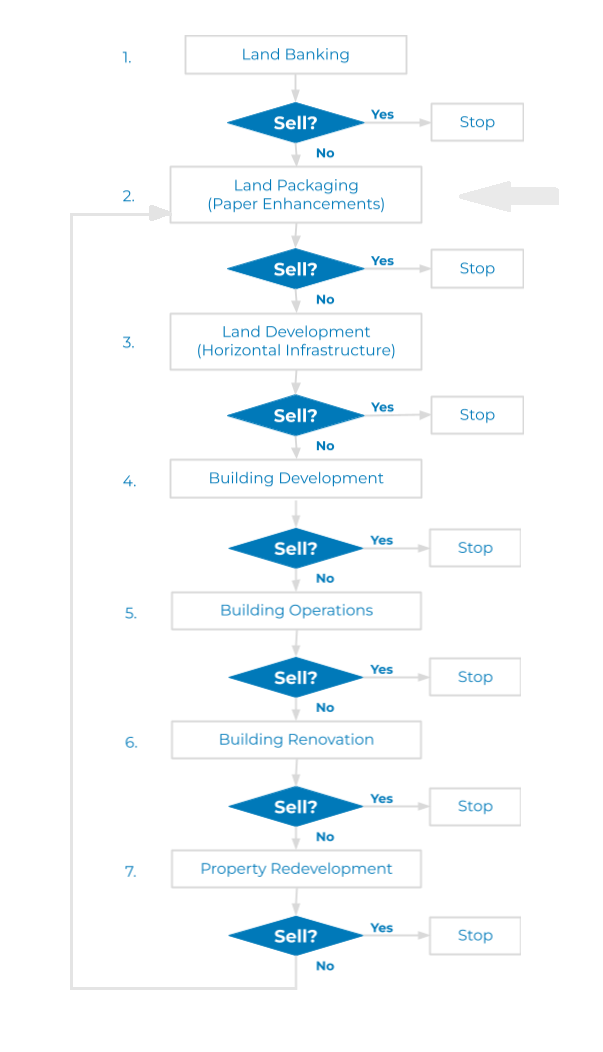
Land flippers include land planning firms, politically savvy lawyers, and government agencies that seek government approvals for their land. Land Developers buy this "land with a plan."
Real Estate Development Process stages are not as neatly segregated. Flipping may overlap with Land Banking or Property Redevelopment as Land flippers try to support municipal annexation, amended zoning provisions, or a new master plan.
Land flippers may need to repair environmental hazards uncovered during the flipping process before Land Developers take over. Land Developers avoid environmental cleanup because it's not well-defined.
How does land flipping work?
In the land flipping equation, purchase price, holding fees, permissions, design, and consultancy costs must be less than Land Developer's sales price.
Land packaging equation
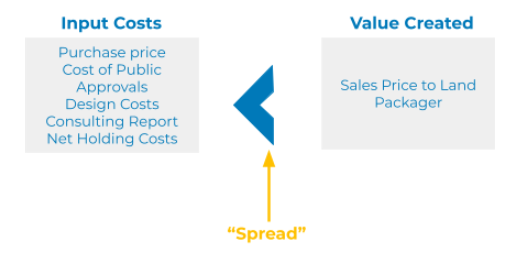
Spread is the difference between two values. Spread is this stage's value difference. Accountants may call this net income or capital gain. Economists term it "profit." This spread may take months or years.
Many real estate developers consider flipping the riskiest stage of the property development process because many public bodies and approvals are involved.
Land flippers have considerable relationships and experience with land-use rules. They must examine the political, environmental, title, and survey challenges.
They are generally retired politicians or municipal leaders, real estate attorneys, brokers, environmental and engineering firms, land planning or architectural firms, or market research firms.
Land flippers recognize it's more vital to govern than possess attractive land parcels. They understand land contracts, installment sales, mortgage purchases, and option agreements. They can acquire land through a lease with purchase options or an extended sales contract.
The cost of retaining land during the flipping process depends on how it was acquired, especially since the timeliness of regulatory processes is unclear.
Key players in the land flipping
Due to the public nature of the real estate development process, land flipping has many significant players. Land flippers must propose their concept for the site to the public and appeal for land use authorization.
They attend meetings and educate stakeholders. This procedure can seem circular due to overlapping roles, but Land Flippers must persevere. They prepare land for construction, making it "shovel ready."
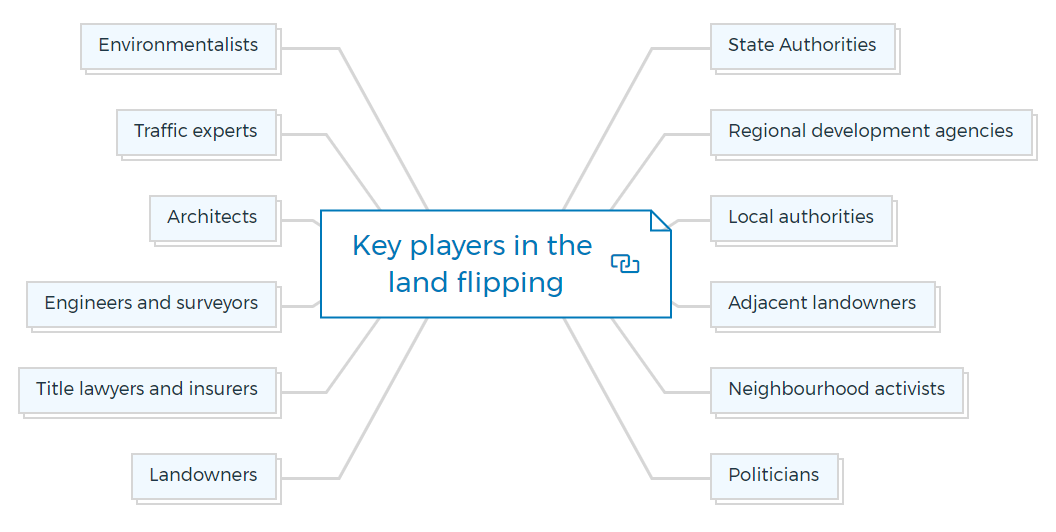
State authorities
These agencies implement federal and state land use regulations and restrictions. The State Department of Environmental Protection will enforce federal and state regulations.
The State Historic Preservation Office will do the same; the State Department of Highways will focus on state highways and transportation systems; the State Department of Natural Resources will have authority if land uses affect state parks or recreation areas.
The state's Fish and Game Commission can intervene if local wildlife is impacted. Land Flippers must decide which entities and authorities must authorize land-use changes.
Regional development agencies
Regional agencies or commissions affect local land use. Regional authorities include:
- Regional water authorities can decide how municipal drinking water is delivered and used.
- Regional sewer authorities can determine the availability and pricing of sewer services in many towns.
- Regional transit authorities operate commuter trains and buses and maintain and extend transit systems across states and municipalities.
- Regional airport authorities control and maintain airports in multiple towns and states.
- A regional planning commission or council of governments designs and enforces regional master plans.
- County governments can control land use in unincorporated regions, townships, boroughs, and cities.
Land flippers must grasp these regional authorities' roles and functions to win their support for proposed land uses.
Local authorities
Local towns govern land use through planning commissions and zoning boards, which have well-defined change procedures. Various municipal departments, such as public works, fire and police, parks and recreation, transportation, and neighborhood associations, assess proposed modifications.
Municipal annexations are governed by state laws and require legislative approval.
Adjacent landowners
Adjacent landowners are crucial to securing licenses and permits, especially at the municipal level. Adjacent landowners may be individuals, corporations, or governments. Each must be informed of the suggested modifications and convinced they'll be advantageous.
Neighborhood activists
These activities operate outside the land use approval process, but their support is crucial. Activists frequently advocate for affordable housing, sustainable development, or improved recreation. Proposed land uses must be politely discussed with them, even if their objection is "no growth, no change".
Politicians
Former or retired politicians may be helpful for lobbying or local planning. They know the system's mechanics.
Landowners
The land seller must be motivated to sell at an attractive price and favorable terms. The sellers may make the sale reliant on approvals or offer seller financing. Their support can help get approvals.
Government agencies often help with property redevelopment approvals. The authorities may offer Land Flipper grants or low-interest loans.
Title lawyers and insurers
Land flippers use title attorneys and insurers to discover title concerns. Sometimes sellers can repair these issues before closing, but sometimes Land flippers can add value. Land flippers must know what dangers or difficulties to accept and avoid.
Engineers and surveyors
Surveyors determine property borders, easements, rights-of-way and boundary concerns. Land Flippers must decide which issues to accept and solve after closing and avoid by insisting the seller rectify them before closing.
Engineers, especially geotechnical engineers, determine the new land plan's geological conditions. They can examine and report on geotechnical issues that affect land use.
Architects
Land planners produce a master plan showing potential land uses. This layout must be flexible and reflect Land flippers' property vision.
Land planners provide maps, drawings, and layouts to help Land Flippers explain planned land-use changes.
Traffic experts
Traffic experts and engineers can predict how proposed land would affect existing and future transportation infrastructure. Identifying the new master plan's traffic requirements or constraints is crucial for approval.
Environmentalists
Environmental professionals undertake surveys and tests to assess the property's environmental issues. They may also recommend remedial measures. Concern for "sustainable development" is widespread.
Sustainability experts help Land flippers describe the sustainable nature of planned land uses and define sustainable development techniques. Land Flippers must handle sustainability issues, which can be unclear.
Significant tasks involved in the land flipping
Land flippers must create "paper infrastructure" for new land uses. They must produce intelligible studies and recommendations for all parties who will determine or influence approvals and permits. Land Flippers must engage in "conceptual selling."
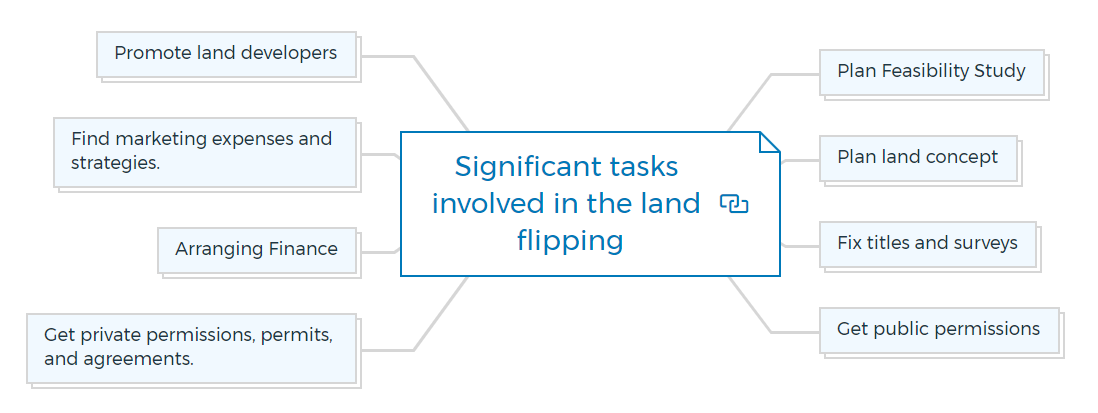
Plan feasibility study
Land Flippers must examine existing and future physical, political, and market variables that will affect site and land usage. They may commission or write their reports. All process participants must easily understand these reports. These reports include:
- Surface, subsurface, and atmospheric conditions;
- Required approvals or permits;
- Market circumstances;
- Site development should consider history or culture.
Plan land concept
Land planners must be renowned and knowledgeable and create a master plan. The conceptual plan should be flexible and reflect feasibility studies and stakeholder concerns.
This plan is for "comment and debate" but may become part of the "Entitlement Documents Package" Master plan authorization legislation generally includes land planners' Urban Design Guidelines.
Fix titles and surveys
Land Flippers can provide value by fixing title or survey issues that have hampered site development. Land Developers require a clear title and detailed survey.
Get public permissions
Each municipality has its approval language. The Land Flipper must know the municipality's land use approval rules and terms for each approval. Approval timing is crucial.
Government boards or commissions can delay or postpone approval reviews without realizing the impact on Land Flippers. The goal is to work the system without alienating public-sector workers. Necessary public approvals must have fair and feasible conditions.
Get private permissions, permits, and agreements
Getting permission from nearby landowners is complicated and contentious. During construction, land flippers may need easements or rights-of-way. In cities, building staging sites are on private land.
Sometimes property transactions, like neighbors abandoning an underutilized right-of-way, are necessary. Public utilities like electric, gas, or water require difficult-to-obtain permits.
Arranging finance
Due to the uncertain length of the approval procedure, Land Flippers must possess the property indefinitely, making regular loan payments difficult. Land Flippers should finance essential expenses with equity or partnership loans from equity partners; seller financing can be crucial.
Option agreements or sales contracts are means to control a property without investing too much cash. Extension clauses are crucial.
Find marketing expenses and strategies
Land Flippers must market the conceptual land plan to the public, stakeholders, and officials. Marketing the project to Land Developers is very vital.
A marketing strategy should incorporate general and specific content provided in person or online, publicly and privately. Cost control is essential.
Promote land developers
Land Developers can acquire land with an authorized land plan and necessary licenses to instantly construct utilities, roads, and other infrastructure. Improving market conditions and favorable financing options are Land Developers' opportunities.
How can you control costs in land flipping?
Land flippers can and must control or minimize controllable costs. Because so many Land Flippers' environments are out of control, controllable expenses must be identified, measured, carefully monitored and managed during the flipping process.
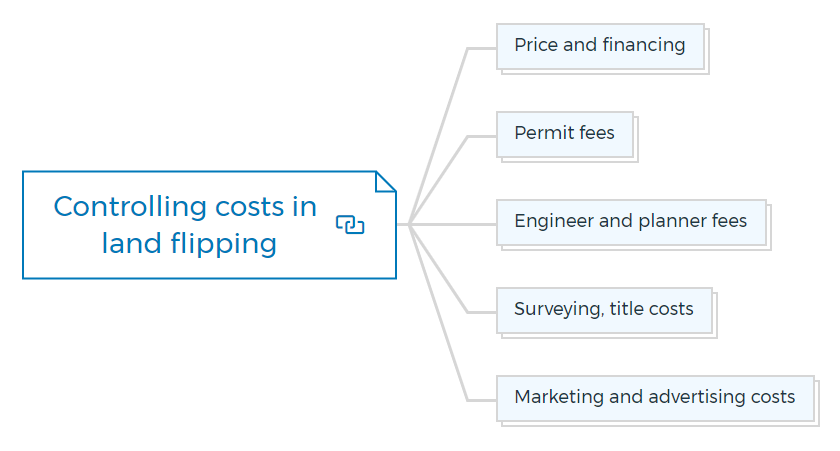
Price and financing
Land Flippers must identify the unpermitted property's investment value and the way to finance it. The purchase agreement should clarify the Land Flipper's financial duties, when they occur, and how to extend them.
Permit fees
Land Flippers must predict what permissions and fees are required and how much they will cost—directly and indirectly—because municipal authorities can change them. Government agencies have similar price structures; therefore, knowing the historical costs of approvals and permits is vital.
Engineer and planner fees
Land planning and engineering fees might rise swiftly if not well managed. Before engagement, fees and job scope should be determined and billed monthly. These professionals are expensive and cannot be employed randomly; thus, public leaders must realize this.
Surveying, title costs
Land acquisition agreements should include surveying and title costs. The seller and buyer could pay survey and title costs or be divided fairly.
These fees might be uncontrollable if not monitored monthly.
ALTA Surveys may not be necessary for property acquisition, but they likely are for selling to Land Developers.
Marketing and advertising costs
Marketing and online advertising budgets must be set and monitored. Land Flippers may want to promote their concept, but the fees might add up quickly. It applies primarily to videos/virtual tours of the proposed development.
Major risks in the land flipping
The Land Flipping Stage is risky if Land Developers can't accomplish the critical tasks on time. Here are the critical risks.
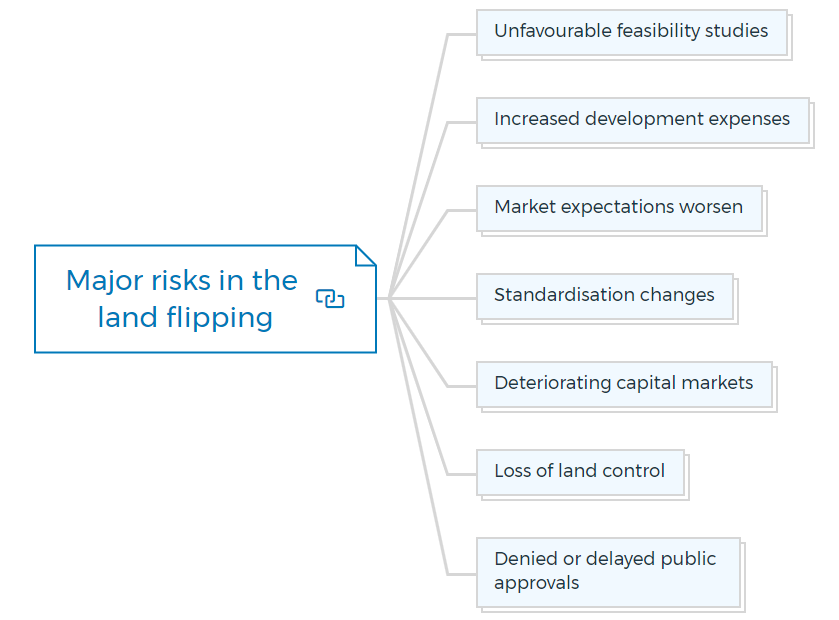
Unfavorable feasibility studies
Feasibility analysis is expensive and may yield poor results. Various feasibility studies were conducted to prove the property's future value and change its existing use.
Sometimes land flippers' most significant concerns are confirmed by feasibility assessments.
- The site is undevelopable
- Regulators won't consider changes
- The planned market is nonexistent.
Land flippers need a realistic exit strategy.
Increased development expenses
The most essential "development expenses'' (hard and soft) are usually the direct construction costs of proposed land or building development enhancements.
These cost hikes are mainly caused by global oil, cement, or steel shortages. Land Flippers often use value engineering at this stage of development costs alter significantly.
Market expectations worsen
Market circumstances may deteriorate. Unfavorable market developments might be due to national or worldwide conditions, such as a banking crisis, or a severe change in local and regional markets, like a significant employer leaving town or shutting down.
Standardization changes
Every government agency can pass regulations that act like laws. Regulations can stop operations like a building moratorium or redefine use modifications like large infrastructure enhancements or governmental programme contributions.
Land flippers must understand current and future rules. When regulators' good intentions harm developers, they revoke or amend the regulations.
Over the last 15 years, stormwater management legislation and the public image of water management ponds have evolved considerably. Public perceptions of sustainable development can lead to regulatory changes.
Deteriorating capital markets
Capital availability and interest rates may rise. Land Flippers must anticipate financial markets that affect Land Developers, Property Developers, and Building Operators.
If Building Operators can't access cash to buy a finished building, Building Developers can't borrow money to build it, and Land Developers can't finance horizontal infrastructure. Land Flippers' intentions are halted.
Loss of land control
Flippers might lose land in several ways. They may default on the purchase agreement, mortgage loan agreement, or option fee. It is sad if Land Flipping is going well.
If Land Flipping isn't working well, this may be a mechanism for flippers to back out. Pre-arranged agreements should detail how Land Flippers exit the contract without liability exposures.
Denied or delayed public approvals
It is the worst real estate flipping outcome. Land Flippers must decide whether to wait for permission or a bailout. Also, acceptance may come with onerous restrictions.
Land flipping is a long process during which the market will cycle, affecting development expenses. The longer the Land Flipping Stage takes, the more market, regulatory, and financing risks increase (favorable or unfavorable).
Final words
While there are various ways to become a Land Banker, they are primarily passive. They wait for prevailing market circumstances to improve or for particular public infrastructure projects to be completed, which will raise the property's value.
Land bankers must thoroughly understand future market forces' positive effects on their property. Their most significant risk is paying holding fees during the indefinite waiting period, precisely when market forces are delayed.
Land Bankers frequently help Land Flippers in selling properties by providing financing or agreeing to favorable conditions of sale.
Know your numbers and make your investment more profitable Property Development Feasibility Suite.
FAQs
Is owning land profitable?
Profitability of owning land depends on a variety of factors, including the location of the land, its zoning , classification, the amount of development that has taken place nearby and more. However, in general, owning land can be a profitable investment, especially if you are able to hold onto it for the long term. The land is profitable because it appreciates in value over time.
Does land ever lose value?
In some cases, land can definitely lose value – for example, if it's no longer usable for its original purpose (like a brownfield site that's been contaminated and can't be redeveloped). Or if it's in a remote location and there's no infrastructure or transport links to support development.
But in other cases, land can gain value – for example, if it becomes scarce and there's a lot of demand for it (like prime city centre real estate). So it really depends on the specific circumstances.

